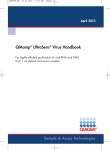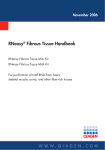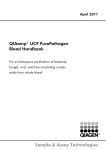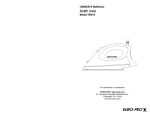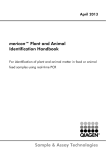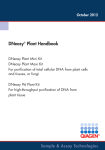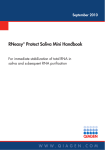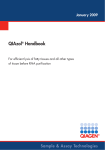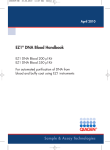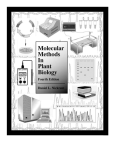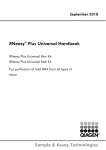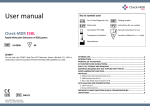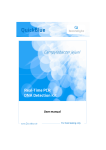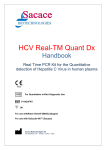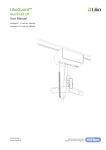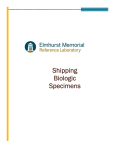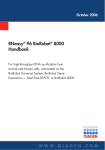Download Sample & Assay Technologies DNeasy® mericon® Food
Transcript
September 2010 DNeasy® mericon™ Food Handbook For extraction of total nucleic acids from a range of food sample types Sample & Assay Technologies QIAGEN Sample and Assay Technologies QIAGEN is the leading provider of innovative sample and assay technologies, enabling the isolation and detection of contents of any biological sample. Our advanced, high-quality products and services ensure success from sample to result. QIAGEN sets standards in: Purification of DNA, RNA, and proteins Nucleic acid and protein assays microRNA research and RNAi Automation of sample and assay technologies Our mission is to enable you to achieve outstanding success and breakthroughs. For more information, visit www.qiagen.com. Contents Kit Contents 4 Storage 4 Product Use Limitations 4 Product Warranty and Satisfaction Guarantee 5 Quality Control 5 Technical Assistance 5 Safety Information 6 Introduction 7 Principle and procedure 7 Description of protocols 8 Equipment and Reagents to Be Supplied by User 10 Important Notes 11 Homogenization 11 Disruption using the QIAGEN TissueRuptor/TissueLyser LT systems 12 Protocols Standard Protocol (2 g) 13 Standard Protocol (200 mg) 15 Small Fragment Protocol (2 g) 18 Small Fragment Protocol (200 mg) 20 Troubleshooting Guide 23 References 26 Ordering Information 27 DNeasy mericon Food Handbook 09/2010 3 Kit Contents DNeasy mericon Food Kit Catalog no. Number of preps Food Lysis Buffer Proteinase K QIAquick® Spin Columns Buffer PB (50) 69514 50 4 x 200 ml 1.4 ml 50 2 x 30 ml Buffer AW2, concentrate 13 ml Buffer EB 15 ml Handbook 1 Storage DNeasy mericon Food Kit components should be stored dry at room temperature (15–25°C). The DNeasy mericon Food Kit can be stored at 2–8°C, but buffers should be redissolved at 37°C before use, if precipitates are observed. Ensure that all buffers and spin columns are at room temperature (15–25°C) before use. DNeasy mericon Food Kits contain a ready-to-use Proteinase K solution, which is supplied in a specially formulated storage buffer. Proteinase K is stable for at least 1 year after delivery when stored at room temperature. For storage longer than one year or if ambient temperatures often exceed 25°C, we suggest storing Proteinase K solution at 2–8°C. DNeasy mericon Food Kit components are stable for 1 year under these conditions without showing reduction in performance and quality. Product Use Limitations The DNeasy mericon Food Kit is intended for molecular biology applications in food, animal feed, and pharmaceutical product testing. This product is not intended for the diagnosis, prevention, or treatment of a disease. 4 DNeasy mericon Food Handbook 09/2010 Product Warranty and Satisfaction Guarantee QIAGEN guarantees the performance of all products in the manner described in our product literature. The purchaser must determine the suitability of the product for its particular use. Should any product fail to perform satisfactorily due to any reason other than misuse, QIAGEN will replace it free of charge or refund the purchase price. We reserve the right to change, alter, or modify any product to enhance its performance and design. If a QIAGEN® product does not meet your expectations, simply call your local Technical Service Department or distributor. We will credit your account or exchange the product — as you wish. Separate conditions apply to QIAGEN scientific instruments, service products, and to products shipped on dry ice. Please inquire for more information. A copy of QIAGEN terms and conditions can be obtained on request, and is also provided on the back of our invoices. If you have questions about product specifications or performance, please call QIAGEN Technical Services or your local distributor (see back cover or visit www.qiagen.com). Quality Control In accordance with QIAGEN’s ISO-certified Quality Management System, each lot of DNeasy mericon Food Kit is tested against predetermined specifications to ensure consistent product quality. Technical Assistance At QIAGEN, we pride ourselves on the quality and availability of our technical support. Our Technical Service Departments are staffed by experienced scientists with extensive practical and theoretical expertise in sample and assay technologies and the use of QIAGEN products. If you have any questions or experience any difficulties regarding the DNeasy mericon Food Kit or QIAGEN products in general, please do not hesitate to contact us. QIAGEN customers are a major source of information regarding advanced or specialized uses of our products. This information is helpful to other scientists as well as to the researchers at QIAGEN. We therefore encourage you to contact us if you have any suggestions about product performance or new applications and techniques. For technical assistance and more information, please see our Technical Support Center at www.qiagen.com/Support or call one of the QIAGEN Technical Service Departments or local distributors (see back cover or visit www.qiagen.com). DNeasy mericon Food Handbook 09/2010 5 Safety Information When working with chemicals, always wear a suitable lab coat, disposable gloves, and protective goggles. For more information, please consult the appropriate material safety data sheets (MSDSs). These are available online in convenient and compact PDF format at www.qiagen.com/Support/MSDS.aspx where you can find, view, and print the MSDS for each QIAGEN kit and kit component. CAUTION: Do not add bleach directly to the samplepreparation waste Buffer PB contains guanidine hydrochloride, which can form highly reactive compounds when combined with bleach. In case liquid containing this buffer is spilt, clean with suitable laboratory detergent and water. The following risk and safety phrases apply to components of the DNeasy mericon Food Kit. Food Lysis Buffer Contains cetyltrimethylammonium bromide (CTAB): Dangerous for the environment. Risk and safety phrases:* R52/53 Proteinase K Contains Proteinase K: Sensitizer, irritant. Risk and safety phrases:* R36/37/3842/43, S23-24-26-36/37 Buffer PB Contains guanidine hydrochloride, isopropanol: Harmful, irritant, flammable. Risk and safety phrases:* R10-22-36/38, S13-23-26-36/37/39-46 24-hour emergency information Emergency medical information in English, French, and German can be obtained 24 hours a day from: Poison Information Center Mainz, Germany Tel: +49-6131-19240 * R10: Flammable; R22: Harmful if swallowed; R36/38: Irritating to eyes and skin; R52/53: Harmful to aquatic organisms, may cause long-term adverse effects in the aquatic environment; R36/37/38: Irritating to eyes, respiratory system and skin; R42/43: May cause sensitization by inhalation and skin contact; S13: Keep away from food, drink, and animal feedingstuffs; S23: Do not breathe vapor; S24: Avoid contact with the skin; S26: In case of contact with eyes, rinse immediately with plenty of water and seek medical advice; S36/37: Wear suitable protective clothing and gloves; S36/37/39: Wear suitable protective clothing, gloves and eye/face protection; S46: If swallowed, seek medical advice immediately and show container or label. 6 DNeasy mericon Food Handbook 09/2010 Introduction In a globalized food market with increasing demand for food research and monitoring, there is a need for streamlined testing solutions that are sensitive, accurate, and easy to use with a variety of starting materials. The mericon food testing portfolio is a complete system of sample preparation and assay kits that meet the demands listed above. Based on detection by realtime polymerase chain reaction (PCR), mericon sample preparation kits and PCR Assays enable fast and reliable detection of a broad range of pathogens, genetically modified organisms, allergens, and plant and animal matter in food, animal feed, or pharmaceutical products. The DNeasy mericon Food Kit is designed for rapid (up to 30 extractions in 2.5 hours) purification of DNA from a variety of raw and processed food matrices, while minimizing the carryover of PCR inhibitors inherent to complex food samples. DNeasy mericon purified DNA is ready for use in a real-time PCR using one of the mericon PCR Assays. Principle and procedure The DNeasy mericon Food Kit uses modified cetyltrimethylammonium bromide (CTAB) extraction. The nonionic detergent CTAB is widely used for efficient extraction of total nucleic acids from a wide range of tissue types. Depending on the salt conditions, CTAB may complex with nucleic acids (low-salt conditions) or complex with inhibitors, such as polysaccharides, proteins, and plant metabolites (high-salt conditions; as found in the Food Lysis Buffer). The optimized protocols for the DNeasy mericon Food Kit use CTAB in combination with Proteinase K to first digest compact tissue and to subsequently precipitate proteins with simultaneous precipitation of other cellular and foodderived inhibitors. Inhibitors are precipitated by centrifugation, while the extracted DNA remains in solution. In the subsequent chloroform extraction, any remaining CTAB-protein, CTAB-debris, or CTAB-polysaccharide complex not precipitated is removed along with other lipophilic inhibitors into the organic phase. Only the aqueous phase containing the DNA and significantly depleted inhibitors is processed further. This phase is mixed with binding buffer (to adjust binding conditions) and applied to the QIAquick Spin Columns. The DNA obtained is ready for use in a downstream mericon real-time PCR assay. DNeasy mericon Food Handbook 09/2010 7 Description of protocols The small fragment protocols are designed for extraction of total DNA from highly processed food material. They have optimized binding conditions for the column purification and are recommended for strongly processed foods, where DNA has been subjected to extensive thermal treatments (e.g., cooking, pasteurization etc.), high pressure, irradiation, pH changes, or drying, and is therefore highly fragmented (down to 100–200 base pairs). These protocols offer more stringent column binding conditions for small DNA fragments and have been successfully used for DNA extraction from foods such as flour and cornflakes. For all other food types and raw materials, the standard protocols should be used. The standard protocols are designed for the extraction of total DNA from complex food samples for which a lower processing grade and thus less DNA fragmentation is expected. We have successfully extracted DNA from foods such as ketchup and chocolate. This handbook contains 2 standard and 2 small fragment protocols, depending on the sample input size (large-scale [2 g] or small-scale [200 mg]). Each protocol has scale-specific adjustments. Therefore, sample and input size should be considered for technical prerequisites (see “Equipment and Reagents to Be Supplied by User”, page 10). However, food samples can be very complex and the processing grade of a specific food is not always clear. It is therefore not possible to predict, which protocol will work best for each sample. The flowchart on the following page may be used as a guide to which protocol is best suited for your sample. 8 DNeasy mericon Food Handbook 09/2010 DNeasy mericon Food Handbook 09/2010 9 Equipment and Reagents to Be Supplied by User When working with chemicals, always wear a suitable lab coat, disposable gloves, and protective goggles. For more information, consult the appropriate material safety data sheets (MSDSs), available from the product supplier. Standard protocol and small fragment protocol (2 g) Homogenizer (see “Important Notes”, page 11) Vortexer Ethanol (96–100%)* Chloroform Centrifuge tubes (50 ml) Microcentrifuge tubes (1.5 ml or 2 ml) Centrifuge with rotor for 50 ml tubes Microcentrifuge with rotor for 1.5 ml or 2 ml tubes, capable of attaining 17,900 x g Shaking incubator or shaking water bath capable of attaining 60°C. Pipets and pipet tips Standard protocol and small fragment protocol (200 mg) Homogenizer (see “Important Notes”, page 11) Vortexer Ethanol (96–100%)* Chloroform Microcentrifuge tubes (2 ml) Microcentrifuge with rotor for 2 ml tubes, capable of attaining 17,900 x g Thermomixer for 2 ml tubes or shaking water bath capable of attaining 60°C. Pipets and pipet tips * Do not use denatured alcohol, which contains other substances such as methanol or methylethylketone. 10 DNeasy mericon Food Handbook 09/2010 Important Notes Homogenization Proper disruption of sample material in the protocols is not only important to facilitate food lysis and liberation of DNA, but is also crucial to guarantee a homogeneous starting material, representative of the whole food product. In this context, anticipated sensitivity and the amount of sample must be considered. The higher the sensitivity requirements (detection of trace amounts of food DNA, e.g., allergens or genetically modified organisms [GMOs]) or the more heterogeneous a food product is (e.g., roughly chopped meats in a sausage), the greater the amount of sample material required for homogenization in order to allow transfer of an overall representative sample into the procedure. In addition to sample size, sample type is also a deciding factor for the homogenization procedure. Both aspects determine the homogenization device best suited for efficient disruption. In order to select the best homogenization device, it should be determined whether the food is soft, hard, or extremely hard. Several options are available for each type of food (see below). Soft samples (e.g., whole fruits in fruit jams or vegetables) Small amount of starting sample: Small knife mill, QIAGEN TissueRuptor®, hand blender Large amount of starting sample: Large knife mill Solid/hard samples (e.g., salami or frozen foods) Small amount of starting sample: Small knife mill, QIAGEN TissueLyser LT, QIAGEN TissueLyser II, mortar and pestle Large amount of starting sample: Large knife mill Extremely solid/hard samples (e.g., roots or seeds) Small amount of starting sample: Small impact mill, QIAGEN TissueLyser LT, QIAGEN TissueLyser II Large amount of starting sample: Large impact mill DNeasy mericon Food Handbook 09/2010 11 Disruption using the QIAGEN TissueRuptor/TissueLyser LT systems Homogenization using the QIAGEN TissueRuptor or TissueLyser systems is best carried out in combination with freezing the sample in liquid nitrogen. This ensures optimal homogenization even with difficult sample material. Disruption using the TissueRuptor should be carried out without Food Lysis Buffer after freezing the sample in liquid nitrogen. Alternatively, fresh material, such as fruits or vegetables, can be directly disrupted in Food Lysis Buffer without using liquid nitrogen; however, this may cause shearing of highmolecular-weight DNA. We recommend keeping the disruption time to a minimum, to avoid shearing of genomic DNA. With the TissueLyser LT, fresh material can be directly disrupted in lysis buffer without the use of liquid nitrogen. Alternatively, fresh or frozen samples can also be disrupted without lysis buffer after freezing in liquid nitrogen. We do not recommend disruption of frozen material in lysis buffer as this can result in low yields and degraded DNA. 12 DNeasy mericon Food Handbook 09/2010 Protocol: Standard Protocol (2 g) This protocol is designed for the extraction of total DNA from a large-scale (2 g) sample of raw or processed food material. Important points before starting All centrifugation steps should be carried out at room temperature (15–25°C) in a microcentrifuge. Vortexing should be performed by pulse-vortexing for 5–10 s. Things to do before starting Homogenize the food sample. For information on disruption procedures and suitable disruption devices, see “Important Notes”, page 11. Buffer AW2 is supplied as a concentrate. Before using for the first time, add the appropriate amount of ethanol (96–100%) as indicated on the bottle to obtain a working solution. Procedure 1. Place 2 g homogenized food sample in a 50 ml centrifuge tube; add 10 ml Food Lysis Buffer and 25 μl Proteinase K solution. Vortex briefly to ensure complete distribution and moistening of the sample material. Note: For samples that swell greatly (e.g., starches), double the amount of Food Lysis Buffer (20 ml) to ensure that sufficient buffer solution covers the sample material. 2. Incubate for 30 min at 60°C with constant shaking. To enhance inhibitor precipitation, cool the sample to room temperature (15–25°C) on ice after incubation. 3. Centrifuge for 5 min at 2500 x g. Note: The volume of supernatant strongly depends on the nature of the applied starting material and the amount of precipitated CTAB-inhibitor complexes. A range of 2 ml (swelling foods, e.g., homogenized cornflakes) to 7 ml (non-swelling homogenized foods e.g., ketchup) can be expected after centrifugation. Do not carry over any precipitate from the bottom of the tube into the subsequent protocol steps. DNeasy mericon Food Handbook 09/2010 13 4. Pipet 500 μl chloroform into a 2 ml microcentrifuge tube. Note: Chloroform is a hazardous substance. Always pipet chloroform in a fume hood. Note: As an organic solvent, chloroform may leak from the pipet tip when transferred from one tube to another. This can be avoided by calibrating the pipet tip to the solvent by repeatedly pipetting up and down before transferring a specific volume. 5. Carefully transfer 700 μl of the clear supernatant from step 3 to the microcentrifuge tube containing the chloroform. Be sure not to carry over material from the bottom phase, which contains precipitated food debris. Note: The supernatant can be strongly colored. Certain foods may also form three phases after centrifugation. If this happens, go through the upper phase with the pipet and transfer only 700 μl of the clear middle phase. If the upper phase has formed a semi-solid film (for example, as observed with chocolate), pierce the film with the pipet and transfer only 700 μl of the clear middle phase. 6. Vortex the microcentrifuge tube from step 5 vigorously for 15 s and centrifuge at 14,000 x g for 15 min. Note: If the supernatant is not clear, centrifuge again for 5 min. 7. Pipet 350 μl Buffer PB into a fresh 2 ml microcentrifuge tube, add 350 μl of the upper, aqueous phase from step 6 and mix thoroughly by vortexing. 8. Pipet the solution from step 7 into the QIAquick spin column placed in a 2 ml collection tube. Centrifuge at 17,900 x g for 1 min and discard the flow-through. Reuse the collection tube in step 9. 9. Add 500 μl Buffer AW2 to the QIAquick spin column, centrifuge at 17,900 x g for 1 min and discard the flow-through. Reuse the collection tube and centrifuge again at 17,900 x g for 1 min to dry the membrane. Note: Ensure that ethanol is added to Buffer AW2. See “Things to do before starting”, page 13. Note: Residual ethanol from Buffer AW2 will not be completely removed unless the flow-through is discarded before the additional centrifugation. 10. Transfer the QIAquick spin column to a 1.5 ml or 2 ml microcentrifuge tube (not supplied), and pipet 150 μl Buffer EB directly onto the QIAquick membrane. Incubate for 1 min at room temperature (15–25°C), and then centrifuge at 17,900 x g for 1 min to elute. 14 DNeasy mericon Food Handbook 09/2010 Protocol: Standard Protocol (200 mg) This protocol is designed for the extraction of total DNA from a small-scale (200 mg) sample of raw or processed food material. Important points before starting All centrifugation steps are carried out at room temperature (15–25°C) in a microcentrifuge. Vortexing should be performed by pulse-vortexing for 5–10 s. This protocol uses a smaller starting food sample size. However, overall DNA yields should be similar to those obtained using the standard protocol. This is because supernatants are pooled in step 5 to ensure that the same amount of sample is processed during DNA purification. Be sure to prepare sufficient lysis tubes to be able to pool samples (3–4 tubes). Things to do before starting Homogenize the food sample. For information on disruption procedures and suitable disruption devices, see “Important Notes”, page 11. Buffer AW2 is supplied as a concentrate. Before using for the first time, add the appropriate amount of ethanol (96–100%) as indicated on the bottle to obtain a working solution. Procedure 1. Place 200 mg homogenized food sample in a 2 ml microcentrifuge tube; add 1 ml Food Lysis Buffer and 2.5 μl Proteinase K solution. Vortex briefly to ensure complete distribution and moistening of the sample material. Note: To ensure that DNA yields are similar to those obtained using the standard protocol (2 g), supernatants are pooled in step 5. Depending on the starting material, the supernatant from the 1 ml lysis solution will be less than 700 μl. Be sure to prepare sufficient lysis tubes (in the range of 3–4 lysis tubes), so that supernatant aliquots from several lysis tubes can be pooled to draw the 700 μl optimal for subsequent chloroform extraction. Note: For samples that swell greatly (e.g., starches), double the amount of Food Lysis Buffer (2 ml) to ensure that sufficient buffer solution covers the sample material. 2. Incubate in a thermomixer for 30 min at 60°C with constant shaking (1000 rpm). To enhance inhibitor precipitation, cool the sample to room temperature (15–25°C) on ice after incubation. DNeasy mericon Food Handbook 09/2010 15 3. Centrifuge for 5 min at 2500 x g. Note: The volume of supernatant strongly depends on the nature of the applied starting material and the amount of precipitated CTAB-inhibitor complexes. A range of 200 μl (swelling foods, e.g., homogenized cornflakes) to 700 μl (non-swelling homogenized foods e.g., ketchup) can be expected after centrifugation. Make sure not to carry over any precipitate from the bottom of the tube into the subsequent protocol steps. 4. Pipet 500 μl chloroform into a 2 ml microcentrifuge tube. Note: Chloroform is a hazardous substance. Always pipet chloroform in a fume hood. Note: As an organic solvent, chloroform may leak from the pipet tip when transferred from one tube to another. This can be avoided by calibrating the pipet tip to the solvent by repeatedly pipetting up and down before transferring a specific volume. 5. Carefully draw the maximum volume of clear supernatant from each lysis tube from step 3 without disturbing the inhibitor precipitate at the bottom at the tube. Combine the supernatant aliquots in one microcentrifuge tube and mix by pipetting up and down several times to ensure a homogeneous solution. 6. Transfer 700 μl of the clear supernatant pool to the microcentrifuge tube containing the chloroform. Note: The supernatant can be strongly colored. Certain foods may form three phases after centrifugation. If this happens, go through the upper phase with the pipet and transfer only an aliquot of the clear middle phase. If the upper phase has formed a semi-solid film (for example, as observed with chocolate), pierce the film with the pipet and transfer only an aliquot of the clear middle phase. 7. Vortex the microcentrifuge tube from step 6 vigorously for 15 s and centrifuge at 14,000 x g for 15 min. Note: If the supernatant is not clear, centrifuge again for 5 min. 8. Pipet 350 μl Buffer PB into a fresh 2 ml microcentrifuge tube, add 350 μl of the upper, aqueous phase from step 7 and mix thoroughly by vortexing. 9. Pipet the solution from step 8 into the QIAquick spin column placed in a 2 ml collection tube. Centrifuge at 17,900 x g for 1 min and discard the flow-through. Reuse the collection tube in step 10. 16 DNeasy mericon Food Handbook 09/2010 10. Add 500 μl Buffer AW2 to the QIAquick spin column, centrifuge at 17,900 x g for 1 min and discard flow-through. Reuse the collection tube and centrifuge again at 17,900 x g for 1 min to dry the membrane. Note: Ensure that ethanol is added to Buffer AW2. See “Things to do before starting”, page 13. Note: Residual ethanol from Buffer AW2 will not be completely removed unless the flow-through is discarded before the additional centrifugation. 11. Transfer the QIAquick spin column to a 1.5 ml or 2 ml microcentrifuge tube (not supplied), and pipet 150 μl Buffer EB directly onto the QIAquick membrane. Incubate for 1 min at room temperature (15–25°C), and then centrifuge at 17,900 x g for 1 min to elute. DNeasy mericon Food Handbook 09/2010 17 Protocol: Small Fragment Protocol (2 g) This protocol is designed for the extraction of total DNA from a large-scale (2 g) sample of raw or processed food material. It has optimized column binding conditions adjusted for maximal recovery of short DNA fragments. It is recommended for strongly processed foods, where DNA has been subjected to extensive thermal treatments (e.g., cooking, pasteurization etc.), high pressure, irradiation, pH changes, or drying, and is therefore highly fragmented (down to 100–200 base pairs). Important points before starting All centrifugation steps should be carried out at room temperature (15–25°C) in a microcentrifuge. Vortexing should be performed by pulse-vortexing for 5–10 s. Things to do before starting Homogenize the food sample. For information on disruption procedures and suitable disruption devices, see “Important Notes”, page 11. Buffer AW2 is supplied as a concentrate. Before using for the first time, add the appropriate amount of ethanol (96–100%) as indicated on the bottle to obtain a working solution. Procedure 1. Place 2 g of homogenized food sample in a 50 ml centrifuge tube; add 10 ml Food Lysis Buffer and 25 μl Proteinase K solution. Vortex briefly to ensure complete distribution and moistening of the sample material. Note: For samples that swell greatly (e.g., starches), use double the amount of Food Lysis Buffer (20 ml) to ensure that sufficient buffer solution covers the sample material. 2. Incubate for 30 min at 60°C with constant shaking. To enhance inhibitor precipitation, cool the sample to room temperature (15–25°C) on ice after incubation. 3. Centrifuge for 5 min at 2500 x g. Note: The volume of supernatant strongly depends on the nature of the applied starting material and the amount of precipitated CTAB-inhibitor complexes. A range of 2 ml (swelling foods, e.g., homogenized cornflakes) to 7 ml (non-swelling homogenized foods e.g., ketchup) can be expected after centrifugation. Make sure not carry over any precipitate from the bottom of the tube into the subsequent protocol steps. 18 DNeasy mericon Food Handbook 09/2010 4. Pipet 500 μl chloroform into a 2 ml microcentrifuge tube. Note: Chloroform is a hazardous substance. Always pipet chloroform in a fume hood. Note: As an organic solvent, chloroform may leak from the pipet tip when transferred from one tube to another. This can be avoided by calibrating the pipet tip to the solvent by repeatedly pipetting up and down before transferring a specific volume. 5. Carefully transfer 700 μl of the clear supernatant from step 3 to the microcentrifuge tube containing the chloroform. Be sure not to carry over material from the bottom phase, which contains precipitated food debris. Note: The supernatant can be strongly colored. Certain foods may also form three phases after centrifugation. If this happens, go through the upper phase with the pipet and transfer 700 μl only of the clear middle phase. If the upper phase has formed a semi-solid film (for example, as observed with chocolate), pierce the film with the pipet and transfer only 700 μl of the clear middle phase. 6. Vortex the microcentrifuge tube from step 5 vigorously for 15 s and centrifuge at 14,000 x g for 15 min. Note: If the supernatant is not clear, centrifuge again for 5 min. 7. Pipet 1 ml Buffer PB into a fresh 2 ml microcentrifuge tube, add 250 μl of the upper, aqueous phase from step 6 and mix thoroughly by vortexing. 8. Pipet 600 μl of the mixture from step 7 into the QIAquick spin column placed in a 2 ml collection tube. Centrifuge at 17,900 x g for 1 min and discard the flow-through. Reuse the collection tube in step 9. 9. Repeat step 8 with remaining sample and discard flow through. Reuse the collection tube in step 10. 10. Add 500 μl Buffer AW2 to the QIAquick spin column, centrifuge at 17,900 x g for 1 min and the discard flow-through. Reuse the collection tube and centrifuge again at 17,900 x g for 1 min to dry the membrane. Note: Ensure that ethanol is added to Buffer AW2. See “Things to do before starting”, page 18. Note: Residual ethanol from buffer AW2 will not be completely removed unless the flow-through is discarded before the additional centrifugation. 11. Transfer the QIAquick spin column to a 1.5 ml or 2 ml microcentrifuge tube (not supplied), and pipet 100 μl Buffer EB directly onto the QIAquick membrane. Incubate for 1 min at room temperature (15–25°C), and then centrifuge at 17,900 x g for 1 min to elute. DNeasy mericon Food Handbook 09/2010 19 Protocol: Small Fragment Protocol (200 mg) This protocol is designed for the extraction of total DNA from a small scale 200 mg sample of raw or processed food material. Column binding conditions are optimized for a maximal recovery of short DNA fragments. It is recommended for strongly processed foods, where DNA has been subjected to extensive thermal treatments (e.g., cooking, pasteurization etc.), high pressure, irradiation, pH changes, or drying, and is therefore highly fragmented (down to 100–200 base pairs). Important points before starting All centrifugation steps should be carried out at room temperature (15–25°C) in a microcentrifuge. Vortexing should be performed by pulse-vortexing for 5–10 s. This protocol uses a smaller starting food sample size. However, overall DNA yields should be similar to those obtained using the standard protocol. This is because supernatants are pooled in step 5 to ensure that the same amount of sample is processed during DNA purification. Be sure to prepare sufficient lysis tubes to be able to pool samples (3–4 tubes). Things to do before starting Homogenize the food sample. For information on disruption procedures and suitable disruption devices, see “Important Notes”, page 11. Buffer AW2 is supplied as a concentrate. Before using for the first time, add the appropriate amount of ethanol (96–100%) as indicated on the bottle to obtain a working solution. 20 DNeasy mericon Food Handbook 09/2010 Procedure 1. Place 200 mg homogenized food sample in a 2 ml microcentrifuge tube; add 1 ml Food Lysis Buffer and 2.5 μl Proteinase K solution. Vortex briefly to ensure complete distribution and moistening of the sample material. Note: To ensure that DNA yields are similar to those obtained using the standard protocol (2 g), supernatants are pooled in step 5. Depending on the starting material, the supernatant from the 1 ml lysis solution will be less than 700 μl. Be sure to prepare sufficient lysis tubes (in the range of 3–4 lysis tubes), so that supernatant aliquots from several lysis tubes can be pooled to draw the 700 μl optimal for subsequent chloroform extraction. Note: For samples that swell greatly (e.g., starches), double the amount of Food Lysis Buffer (2 ml) to ensure that a sufficient level of buffer solution covers the sample material. 2. Incubate in a thermomixer for 30 min at 60°C with constant shaking (1000 rpm). To enhance inhibitor precipitation, cool the sample to room temperature (15–25°C) on ice after incubation. 3. Centrifuge for 5 min at 2500 x g. Note: The volume of supernatant strongly depends on the nature of the applied starting material and the amount of precipitated CTAB-inhibitor complexes. A range of 200 μl (swelling foods, e.g., homogenized cornflakes) to 700 μl (non-swelling homogenized foods e.g., ketchup) can be expected after centrifugation. Make sure not carry over any precipitate from the bottom of the tube into the subsequent protocol steps. 4. Pipet 500 μl chloroform into a 2 ml microcentrifuge tube. Note: Chloroform is a hazardous substance. Always pipet chloroform in a fume hood. Note: As an organic solvent, chloroform may leak from the pipet tip when transferred from one tube to another. This can be avoided by calibrating the pipet tip to the solvent by repeatedly pipetting up and down before transferring a specific volume. 5. Carefully draw the maximum volume of clear supernatant from each lysis tube replicate from step 3 without disturbing the inhibitor precipitate at the bottom at the tube. Combine the supernatant aliquots in one microcentrifuge tube and mix by pipetting up and down several times to ensure a homogeneous solution. DNeasy mericon Food Handbook 09/2010 21 6. Transfer 700 μl of the clear supernatant pool to the microcentrifuge tube containing the chloroform. Note: The supernatant can be strongly colored. Certain foods may also form three phases after centrifugation. If this happens, go through the upper phase with the pipet and transfer only an aliquot of the clear middle phase. If the upper phase has formed a semi-solid film (for example, as observed with chocolate), pierce the film with the pipet and transfer only an aliquot of the clear middle phase. 7. Vortex the microcentrifuge tube from step 6 vigorously for 15 s and centrifuge at 14,000 x g for 15 min. Note: If the supernatant is not clear, centrifuge again for 5 min. 8. Pipet 1 ml Buffer PB into a fresh 2 ml microcentrifuge tube, add 250 μl of the upper, aqueous phase from step 7 and mix thoroughly by vortexing. 9. Pipet 600 μl of the mixture from step 8 into the QIAquick spin column placed in a 2 ml collection tube. Centrifuge at 17,900 x g for 1 min and discard the flow-through. Reuse the collection tube in step 9. 10. Repeat step 9 with remaining sample and discard flow through. Reuse the collection tube in step 11. 11. Add 500 μl Buffer AW2 to the QIAquick spin column, centrifuge at 17,900 x g for 1 min and the discard flow through. Reuse the collection tube and centrifuge again at 17,900 x g for 1 min to dry the membrane. Note: Ensure that ethanol is added to Buffer AW2. See “Things to do before starting”, page 18. Note: Residual ethanol from buffer AW2 will not be completely removed unless the flow-through is discarded before the additional centrifugation. 12. Transfer the QIAquick spin column to a 1.5 ml or 2 ml microcentrifuge tube (not supplied), and pipet 100 μl Buffer EB directly onto the QIAquick membrane. Incubate for 1 min at room temperature (15–25°C), and then centrifuge at 17,900 x g for 1 min to elute. 22 DNeasy mericon Food Handbook 09/2010 Troubleshooting Guide This troubleshooting guide may be helpful in solving problems that may arise. For more information, see also the Frequently Asked Questions page at our Technical Support Center: www.qiagen.com/FAQ/FAQList.aspx. The scientists in QIAGEN Technical Services are always happy to answer any questions you may have about either the information and protocols in this handbook or sample and assay technologies (for contact information, see back cover or visit www.qiagen.com). Comments and suggestions Solid film formed on the lysis solution after incubation at 60°C and subsequent centrifugation Liberated food components are deposited or compacted on top of the reaction solution after lysis Continue with the protocol and pierce any top layer with the pipet. Carefully draw the 700 μl aliquot from the clear middle phase, making sure that the pipet tip is not blocked by food deposits. No supernatant from which to draw the 700 μl aliquot after incubation at 60°C and subsequent centrifugation a) Insufficient food disruption and subsequent swelling of food (e.g., cornflakes) Make sure that the food is completely homogenized before adding the Food Lysis Buffer. b) Strong swelling of already homogenized food (e.g., starches) Apply the same amount of sample, but double the amount of Food Lysis Buffer. DNeasy mericon Food Handbook 09/2010 23 Comments and suggestions QIAquick membrane is colored Food inhibitors carried over from lysis/inhibitor precipitation and chloroform extraction are deposited on the membrane After washing with Buffer AW2, perform an additional wash step using 500 μl ethanol (96–100%). Centrifuge for 2 min at 20,000 x g to dry the membrane and continue with the protocol. In general inhibitors are one of the following: Retained by the membrane. Membrane remains colored after washing and elution but DNA elution and quality are unaffected Removed by additional ethanol wash step Co-eluted into DNA solution. See “DNA does not perform well in downstream experiments”, below. DNA eluate is colored Inhibitor carryover See ‘”DNA does not perform well in downstream experiments”, below. Low DNA yield a) Insufficient disruption Ensure that the starting material is completely disrupted. See “Disruption using the QIAGEN TissueRuptor/TissueLyser LT systems”, page12. b) Insufficient lysis Reduce the amount of starting material and/or increase the amount of Food Lysis Buffer. Check that the correct amount of Proteinase K has been added to the lysis reaction. If necessary, extend incubation time at 60°C for Proteinase K digest to 90 min and/or increase the amount of Proteinase K to 50 μl. c) Buffer AW2 prepared incorrectly 24 Make sure that ethanol has been added to Buffer AW2 before use (see “Things to do before starting”, page 13 or 18, depending on which protocol is being used). DNeasy mericon Food Handbook 09/2010 Comments and suggestions d) Incorrect binding conditions Make sure that the correct amount of lysate has been pipetted after the chloroform extraction and is mixed 1:1 (standard protocol) or 1:4 (small fragment protocol) with Buffer PB to adjust the binding conditions correctly. e) DNA is still bound to the membrane Increase the volume of Buffer EB to 200 μl and incubate on the column for 5 min at room temperature (15–25 °C) before centrifugation. DNA does not perform well in downstream experiments a) Inhibitor carryover A possible inhibitor carryover is sometimes, although not necessarily, identified by a colored eluate. Dilute the sample at least 1:10 before PCR analysis. b) Ethanol carryover Ensure that a dry spin step is performed after washing with Buffer AW2. The flow-through after the wash needs to be discarded before the dry spin to allow complete drying of the membrane. c) Salt carryover Ensure that Buffer AW2 has been used at room temperature (15–25°C). d) Insufficient or excess DNA used in downstream application Optimize the amount of DNA used in the downstream application, if necessary. Downstream applications can be adversely affected by insufficient or excess DNA. DNeasy mericon Food Handbook 09/2010 25 References QIAGEN maintains a large, up-to-date online database of scientific publications utilizing QIAGEN products. Comprehensive search options allow you to find the articles you need, either by a simple keyword search or by specifying the application, research area, title, etc. For a complete list of references, visit the QIAGEN Reference Database online at www.qiagen.com/RefDB/search.asp or contact QIAGEN Technical Services or your local distributor. 26 DNeasy mericon Food Handbook 09/2010 Ordering Information Product Contents Cat. no. mericon Sample Preparation Kits DNeasy mericon Food Kit (50) 50 QIAquick Spin Columns, Proteinase K, buffers 69514 mericon DNA Bacteria Kit (100) Fast Lysis Buffer 69525 mericon DNA Bacteria Plus Kit (50) 50 Pathogen Lysis Tubes L, Fast Lysis Buffer 69534 mericon Salmonella spp Kit (24)* For 24 reactions: mericon Salmonella Assay, Internal Control, Positive Control, Multiplex PCR Master Mix, QuantiTect® Nucleic Acid Dilution Buffer, RNase-free water 290013 mericon L. monocytogenes Kit (24)* For 24 reactions: mericon L. monocytogenes Assay, Internal Control, Positive Control, Multiplex PCR Master Mix, QuantiTect Nucleic Acid Dilution Buffer, RNase-free water 290023 mericon Campylobacter spp Kit (24)* For 24 reactions: mericon Campylobacter spp. Assay, Internal Control, Positive Control, Multiplex PCR Master Mix, QuantiTect Nucleic Acid Dilution Buffer, RNase-free water 290033 mericon Campylobacter triple Kit (24)* For 24 reactions: mericon Campylobacter triple Assay, Internal Control, Positive Control, Multiplex PCR Master Mix, QuantiTect Nucleic Acid Dilution Buffer, RNase-free water 290043 mericon VTEC stx1/2 Kit (24)* For 24 reactions: mericon VTEC stx1/2 Assay, Internal Control, Positive Control, Multiplex PCR Master Mix, QuantiTect Nucleic Acid Dilution Buffer, RNase-free water 290053 mericon Assay Kits * Larger kit sizes available; please inquire. DNeasy mericon Food Handbook 09/2010 27 Product Contents Cat. no. mericon C. sakazakii Kit (24)* For 24 reactions: mericon C. sakazakii Assay, Internal Control, Positive Control, Multiplex PCR Master Mix, QuantiTect Nucleic Acid Dilution Buffer, RNase-free water 290063 mericon S. aureus Kit (24)* For 24 reactions: mericon S. aureus Assay, Internal Control, Positive Control, Multiplex PCR Master Mix, QuantiTect Nucleic Acid Dilution Buffer, RNase-free water 290073 mericon Legionella spp Kit (24)* For 24 reactions: mericon Legionella spp. Assay, Internal Control, Positive Control, Multiplex PCR Master Mix, QuantiTect Nucleic Acid Dilution Buffer, RNase-free water 290083 mericon L. pneumophila Kit (24)* For 24 reactions: mericon L. pneumophila Assay, Internal Control, Positive Control, Multiplex PCR Master Mix, QuantiTect Nucleic Acid Dilution Buffer, RNase-free water 290093 mericon Shigella spp Kit (24)* For 24 reactions: mericon Shigella spp Assay, Internal Control, Positive Control, Multiplex PCR Master Mix, QuantiTect Nucleic Acid Dilution Buffer, RNase-free water 290103 mericon Y. enterocolitica Kit (24)* For 24 reactions: mericon Y. enterocolitica Assay, Internal Control, Positive Control, Multiplex PCR Master Mix, QuantiTect Nucleic Acid Dilution Buffer, RNase-free water 290113 * Larger kit sizes available; please inquire. 28 DNeasy mericon Food Handbook 09/2010 Product Contents Cat. no. Related products mericon GMO Detection Assays mericon Screen 35S Kit (24)* For 24 reactions: mericon Screen 35S Assay, Internal Control, Positive Control, mericon Master Mix, QuantiTect Nucleic Acid Dilution Buffer, RNase-free water 291013 mericon Screen Nos Kit (24)* For 24 reactions: mericon Screen Nos Assay, Internal Control, Positive Control, mericon Master Mix, QuantiTect Nucleic Acid Dilution Buffer, RNase-free water 291043 mericon RR Soy (24)* For 24 reactions: mericon RR Soy Assay, Internal Control, Positive Control, mericon Master Mix, QuantiTect Nucleic Acid Dilution Buffer, RNase-free water 291113 mericon Animal and Plant Identification Assays mericon Pig Kit (24)* For 24 reactions: mericon Pig Assay, Internal Control, Positive Control, mericon Master Mix, QuantiTect Nucleic Acid Dilution Buffer, RNasefree water 292013 mericon Pig Kit (24)* For 24 reactions: mericon Pig Assay, Internal Control, Positive Control, mericon Master Mix, QuantiTect Nucleic Acid Dilution Buffer, RNasefree water 292013 For up-to-date licensing information and product-specific disclaimers, see the respective QIAGEN kit handbook or user manual. QIAGEN kit handbooks and user manuals are available at www.qiagen.com or can be requested from QIAGEN Technical Services or your local distributor. * Larger kit sizes available; please inquire. DNeasy mericon Food Handbook 09/2010 29 Notes 30 DNeasy mericon Food Handbook 09/2010 Trademarks: QIAGEN®, QIAquick®, DNeasy®, mericon™, QuantiTect®, TissueRuptor® (QIAGEN Group). Limited License Agreement Use of this product signifies the agreement of any purchaser or user of the DNeasy mericon Food Kit to the following terms: 1. The DNeasy mericon Food Kit may be used solely in accordance with the DNeasy mericon Food Handbook and for use with components contained in the Kit only. QIAGEN grants no license under any of its intellectual property to use or incorporate the enclosed components of this Kit with any components not included within this Kit except as described in the DNeasy mericon Food Handbook and additional protocols available at www.qiagen.com. 2. Other than expressly stated licenses, QIAGEN makes no warranty that this Kit and/or its use(s) do not infringe the rights of third-parties. 3. This Kit and its components are licensed for one-time use and may not be reused, refurbished, or resold. 4. QIAGEN specifically disclaims any other licenses, expressed or implied other than those expressly stated. 5. The purchaser and user of the Kit agree not to take or permit anyone else to take any steps that could lead to or facilitate any acts prohibited above. QIAGEN may enforce the prohibitions of this Limited License Agreement in any Court, and shall recover all its investigative and Court costs, including attorney fees, in any action to enforce this Limited License Agreement or any of its intellectual property rights relating to the Kit and/or its components. For updated license terms, see www.qiagen.com. © 2010 QIAGEN, all rights reserved. www.qiagen.com Australia Orders 1-800-243-800 Fax 03-9840-9888 Technical 1-800-243-066 Austria Orders 0800-28-10-10 Fax 0800-28-10-19 Technical 0800-28-10-11 Belgium Orders 0800-79612 Fax 0800-79611 Technical 0800-79556 Brazil Orders 0800-557779 Fax 55-11-5079-4001 Technical 0800-557779 Canada Orders 800-572-9613 Fax 800-713-5951 Technical 800-DNA-PREP (800-362-7737) China Orders 86-21-3865-3865 Fax 86-21-3865-3965 Technical 800-988-0325 Denmark Orders 80-885945 Fax 80-885944 Technical 80-885942 Finland Orders 0800-914416 Fax 0800-914415 Technical 0800-914413 France Orders 01-60-920-926 Fax 01-60-920-925 Technical 01-60-920-930 Offers 01-60-920-928 Germany Orders 02103-29-12000 Fax 02103-29-22000 Technical 02103-29-12400 Hong Kong Orders 800 933 965 Fax 800 930 439 Technical 800 930 425 Ireland Orders 1800 555 049 Fax 1800 555 048 Technical 1800 555 061 Italy Orders 800-789-544 Fax 02-334304-826 Technical 800-787980 Japan Telephone 03-6890-7300 Fax 03-5547-0818 Technical 03-6890-7300 Korea (South) Orders 080-000-7146 Fax 02-2626-5703 Technical 080-000-7145 Luxembourg Orders 8002-2076 Fax 8002-2073 Technical 8002-2067 Mexico Orders 01-800-7742-639 Fax 01-800-1122-330 Technical 01-800-7742-436 The Netherlands Orders 0800-0229592 Fax 0800-0229593 Technical 0800-0229602 Norway Orders 800-18859 Fax 800-18817 Technical 800-18712 Singapore Orders 1800-742-4362 Fax 65-6854-8184 Technical 1800-742-4368 Spain Orders 91-630-7050 Fax 91-630-5145 Technical 91-630-7050 Sweden Orders 020-790282 Fax 020-790582 Technical 020-798328 Switzerland Orders 055-254-22-11 Fax 055-254-22-13 Technical 055-254-22-12 UK Orders 01293-422-911 Fax 01293-422-922 Technical 01293-422-999 USA Orders 800-426-8157 Fax 800-718-2056 Technical 800-DNA-PREP (800-362-7737) 1063925 09/2010 Sample & Assay Technologies
































